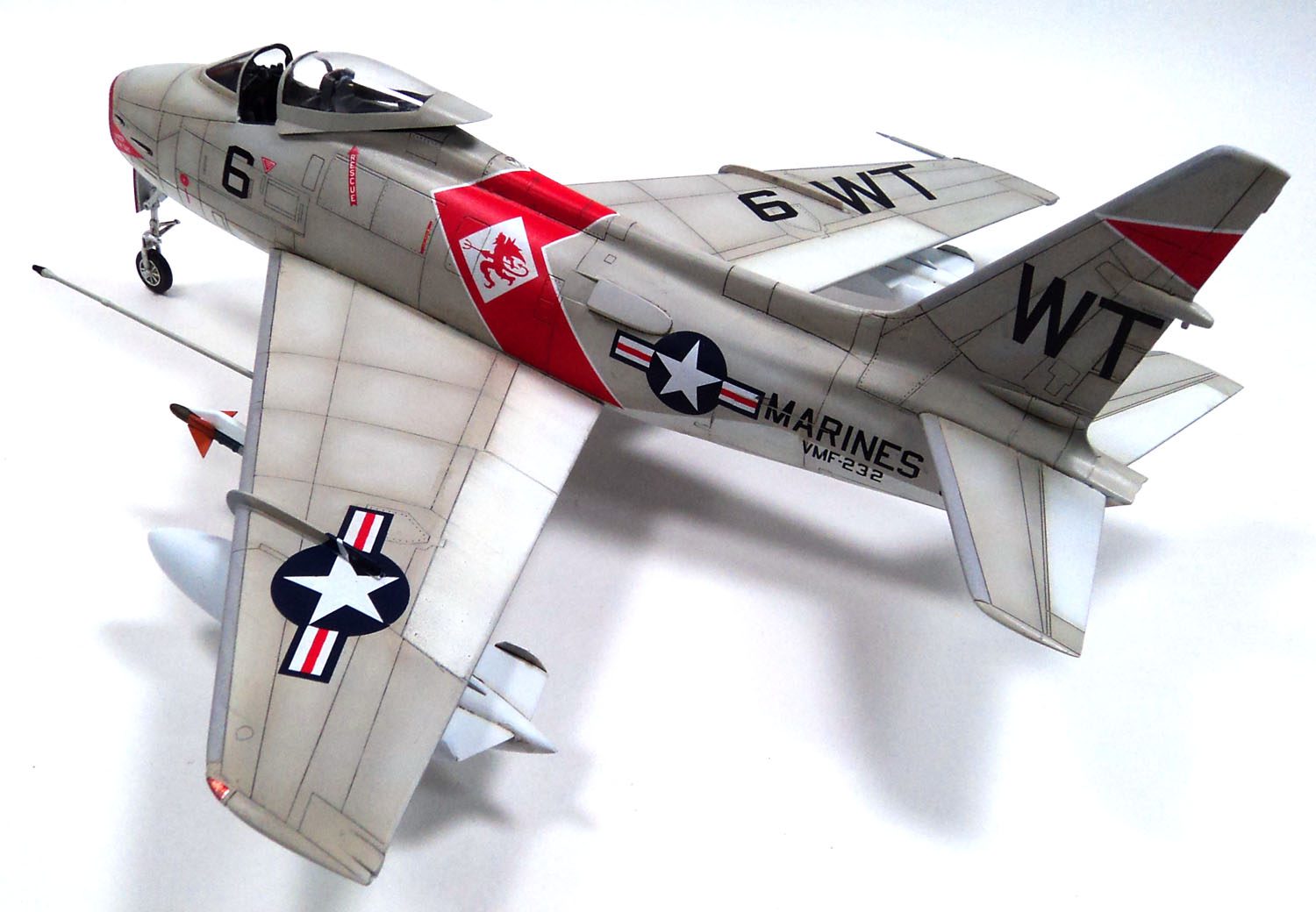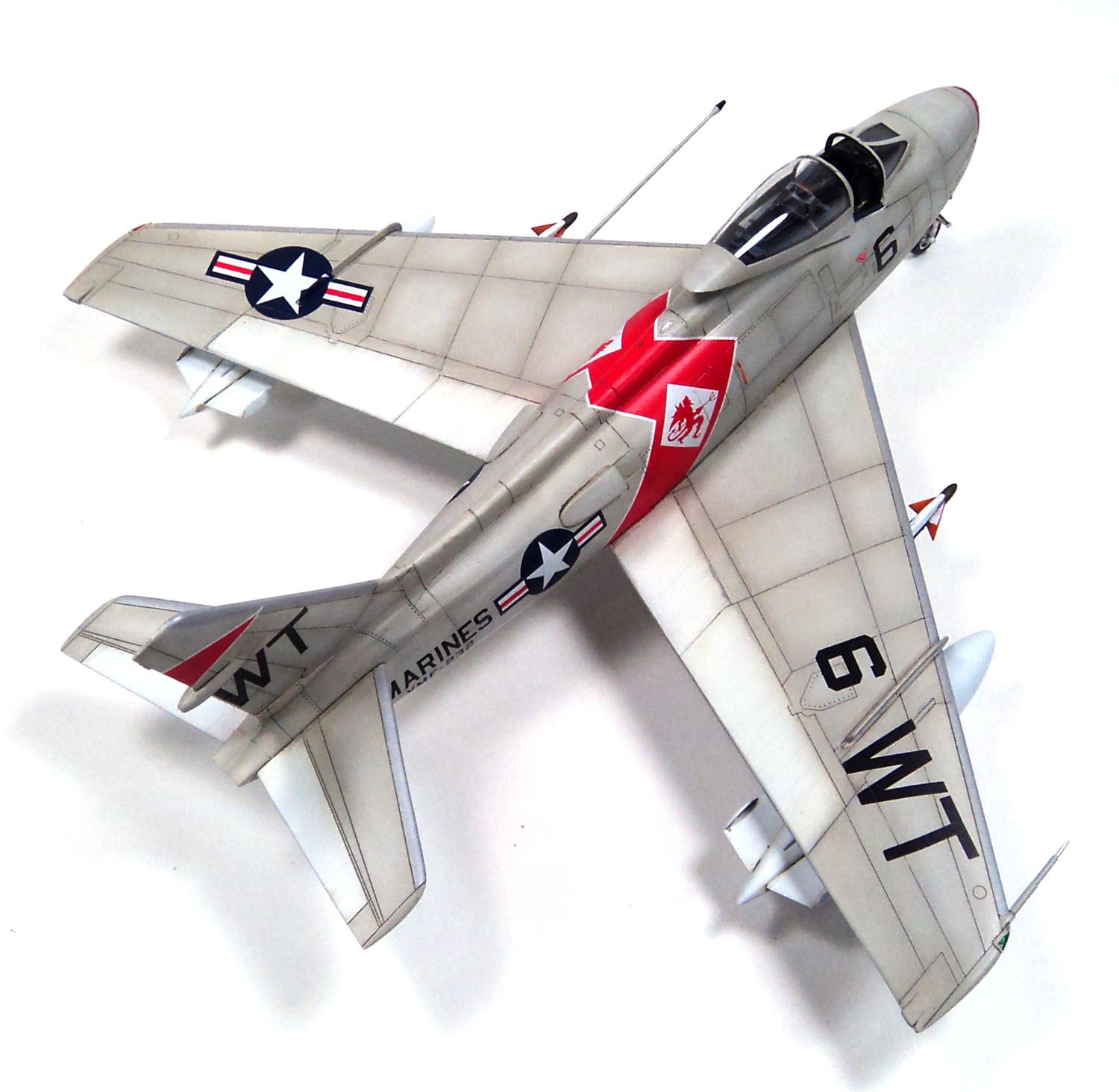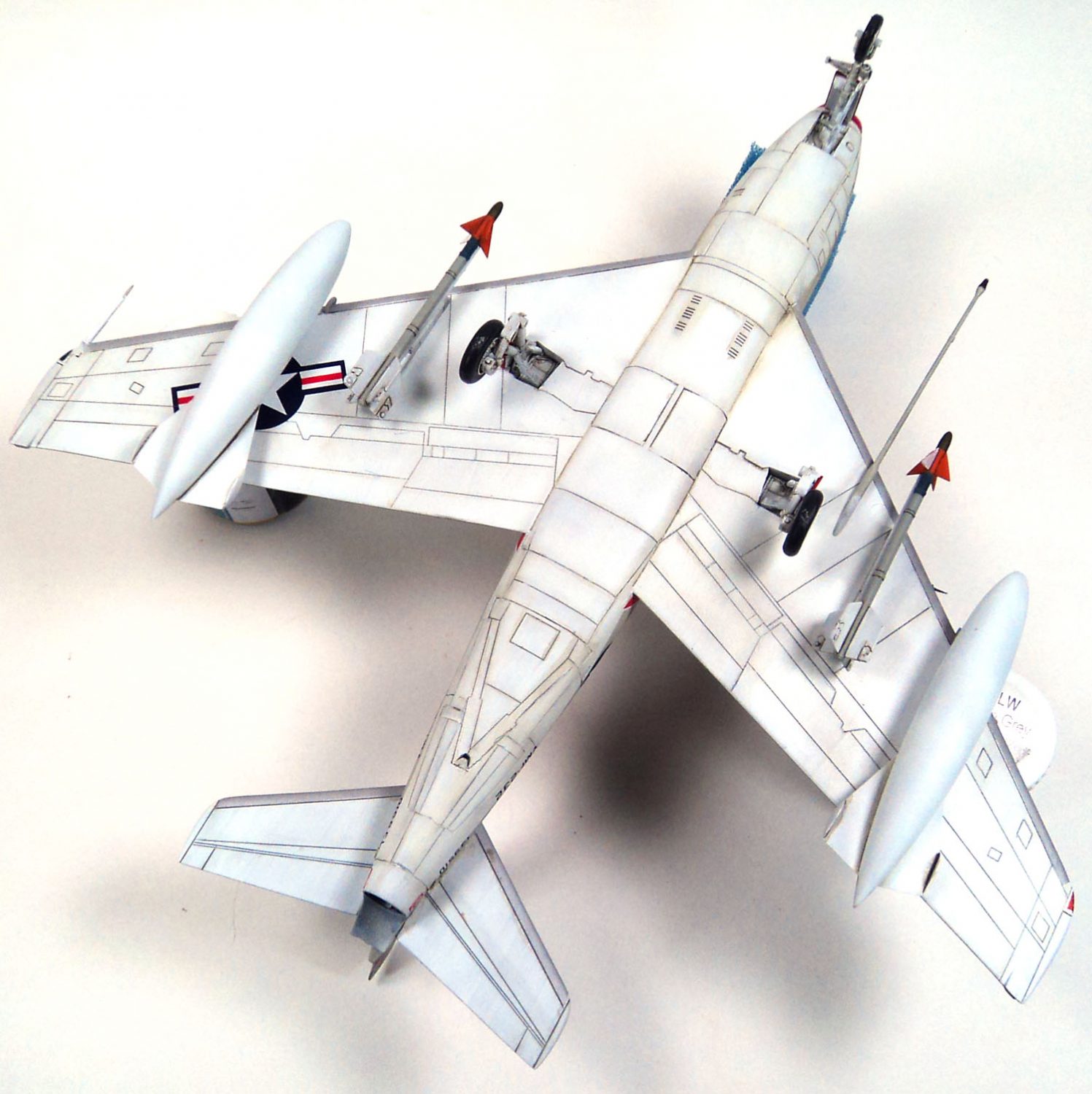After tackling a tougher kit over the Memorial Day holiday, I decided to spend my vacation time for Independence Day on a slightly simpler kit. This time the kit of choice was Hobbyboss’ 1/48 FJ-4 Fury. (Hobbyboss Kit # 80312)
The kit looked promising. Simple parts breakdown, a relatively simple scheme. Nothing too fiddly. By all appearances, it would take an idiot to mess this one up.
Hmmm… challenge accepted.
The kit is broken down conventionally, with left and right fuselage halves, a single lower wing part, two upper wing halves, and all associated internal parts in their own sections. The cockpit is a mixed bag. Separate side consoles have great raised detail, yet the instrument panel has only the barest raised lines that are about useless. The seat is decent looking, but no belts are provided. The Fury had a bit of detail aft of the seat under the canopy, but none is provided.
Wheel wells are nicely detailed, as are the gear legs and associated struts. The kit is intended to be built with air brakes open, but I chose to shut them up. (They were kinda mouthy anyway… 🙂 )
To improve the look of the cockpit, and to avoid having to use photoetch belts, I used a True Details 1/48 F-86F seat, which only needed a tiny bit of sanding to fit. Mike Grant Decals instrument decals improved the instrument panel.
Some additional scratch building took care of the area aft of the seat. I didn’t really try to replicate the real thing, but rather added enough bits and pieces to look reasonably busy.
The cockpit tub is supposed to be mated with the air intake trunk, and the completed unit placed inside the cockpit. Later the actual air intake opening is placed on the aircraft. Test fitting showed this would leave some pretty serious alignment issues to be dealt with.
A bit of experimentation showed that the cockpit fit nicely without the trunking, and with the alignment tabs removed from the trunk, it could be slid in place after fuselage assembly. (A little sanding was required on the aft end of the trunking to avoid catching anything- I just “rounded off” the edges.)
This method allowed the trunking to be mated to the air intake ahead of time, and with some Mr. Surfacer and a bit of sanding, a nice (mostly) seamless join was achieved. Once the cockpit and nose wheel well were in place (as well as a bit of nose weight to avoid tail sit), the fuselage halves were glued together and the seams were dealt with.
I decided to ensure that the nose weight was enough by adding some Liquid Gravity into the intake trunk, gluing it in place, and then painting it all black. When that was dry, I airbrushed white into the opening, which resulted in a nice transition from white to black. Looking into the air intake, you can’t really see the weight at all.
That assembly was added to the fuselage, and the wings were then assembled. Fit for the wings was perfect, only a bit of sanding to remove the seam needed. Test fitting the wing to the fuselage showed a bit of a gap, so a fuselage spreader was added, and with a little adjustment, resulted in a near perfect fit. With wings on, the tailplanes were added, and then after a final sanding, work started on the paint.
(One other note- delete the holes for the innermost pylons. Those are only used on the FJ-4B kit, Hobbyboss kit # 80313.)
The undersides were painted with Tamiya XF-2 White, thinned with lacquer thinner. This went down super smooth. The finish was so nice I went ahead and painted the upper parts too, using the white as a simple primer.
For the upper color, I’d planned to use Vallejo Light Gull Gray. However, as this build was on a tight deadline, I had concerns over masking the Vallejo paint to spray the Coroguard (silver) areas on the leading edges of the flying surfaces. While I did not really like using Gunze instead, I thought that because I could thin it with lacquer thinner, it would dry and hold much better. And it did.
After a little drying time (plenty if I had used Tamiya…), I masked off for the Corguard. Spraying that on, I removed the masking.
Somehow, the tape (Tamiya tape) had reacted with the Gunze paint, and left awful sticky marks. I sanded those back a bit, and then pulling out the Gunze paint, thinned some up and begain to repair the affected areas.
Only to find that the paint color had shifted slightly.
Puzzled by the this, I did some experiments. It turned out that variations in thinning ratios altered the color to the point that a match was near impossible. After painting the affected areas, I decided to pause and think things over.
Falling back on the “weathering hides everything” line of reasoning, I began to post shade and fade it all pretty heavily. Then I thought “Hey, the old mechanical pencil trick will sure make those panel lines pop!”
So I compounded my growing problems even more.
By the time I’d “finished weathering”, it look like a serious mess. Resisting the urge to throw it all in the trash, I retired to my recliner for the evening and contemplated how to fix this disaster of my own making.
I awoke about 3:45 AM the next morning, solution in mind. I’d mask off the Corguard areas, treat the previous night mess as “pre-shading”, and respray both the white and the gull gray. Only this time, I’d forget the Gunze stuff (it’s in the trash now, in fact…) and Vallejo, and work up a Tamiya mix.
Gull gray is a fairly distinct color color. While it is a light gray, it has just a touch of warmth to it… a tad tan, perhaps? Looking over my Tamiya paint, I noticed XF-20 Medium Gray had a similar warmth to it, but was a bit darker. Throwing caution to the wind, I mixed one part of the XF-20 with two parts of XF-2, and the result…. worked. In fact, it was just about spot on.
So- game on.
With my gaffe covered over, I moved on to the decals. While the red is a bit too bright, Hobbyboss’ decals performed flawlessly. I did have to resort to some hand painting to sort out the red decal on the intake, but otherwise they fit nicely. (Although their spelling is atrocious…. Bewarc jeimblast?)
With decals on, the final bits were added- landing gear, fuel tanks and missiles (yes, those colors are correct…), and other bits. A final flat coat was added, the canopy unmasked, and I’m calling this Holiday build finished.
The kit is a superb little build. A few modifications to the build sequence will avoid any alignment issues with the air intake, and a simple fuselage spreader will assure a good wing fit. Apart from those two items, this one is a simple build anyone can take on- and really enjoy.
All told, I spent about 30 hours over four days building this jet.











Leave a Reply